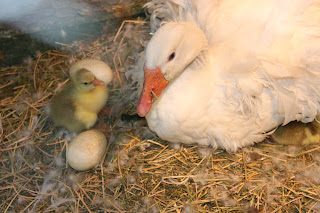I also occasionally sprinkle Cayenne in my chickens food. Especially during the winter, or the wet months. It actually creates heat within their bodies with the increased circulation which helps to keep their immune systems up and prevent disease. Chickens don't really have a sense of smell, and they DO have taste buds, but they are so far back in their mouths that by the time anything hits them, is probably too late to spit it back out. So they don't really complain about about the "Mexican food" I serve up. :-)
And just so you know I practice what I preach, these methods work just as well on people as they do the barnyard critters. My husband and I both will take a few drops of super hot cayenne extract by mouth when we have a cold or sinus infection. It literally blows out the infection, clears out the mucous and sets your senses on fire! I'd also like to clear up a bit of a misconception on hot peppers. Many people are afraid to try them on an open wound because of the "burn" factor. But I have found that in a situation where your body is already inflamed and aggravated Cayenne can actually be soothing to the touch. I know, I know, it sounds crazy, but next time you get a paper cut, try it out and see what you think. Sprinkle a little in a bandaid and slap it on your finger. If you don't notice how fast you heal, you weren't paying attention.
I'm going to step out further on my every growing limb here and declare that Cayenne can even stop a heart attack in its tracks! Famous herbalist, Dr. John Christopher, N.D. sang the praises of Cayenne pepper and declared: "In 35 years of practice, and working with the people and teaching, I have never on house calls, lost one heart attach patient and the reason is, whenever I go in--if they are still breathing--I pour down them a cup of cayenne tea (a teaspoon of cayenne in a cup of hot water), and within minutes they are up and around." That is a pretty powerful statement, my friends. Now of course I am not qualified to give you medical advice, but I think if i were in this type of situation, I would sure want somebody to give me some cayenne!
My husband even remembers when his little sister was badly burned on an iron, and their mom cut open a fresh Cayenne pepper and rubbed it directly over the burn. The capsaicin prevents the blistering and stimulates healing. Cayenne has numerous other uses including aiding digestion, boosting metabolism and helping with weightloss. So I would encourage you to study up on it even more. There is lots of information available about it online.
The hotness and intensity of peppers is measured in heat units, or Scoville Units and Cayenne usually falls in the 30,000-50,000 range, but you can find it in the 60,000-90,000 range if you want to increase your intake after a while. It is not the heat alone that heals, as Cayenne is more beneficial than other hot peppers. So give it a try, and tell me what you figure out! Here are some good options if you want to start taking it as a supplement (Click image to see product details and purchase info):
Also for animals, like I said you can just get the really inexpensive stuff, its still potent enough to help. And here is a bulk bag of it:

Now just to cover my @$& I need to say that these statements have not be evaulated by the FDA and that this information is not intended to be used as medical advice as the author is not a physician. Cayenne has not been proven to treat, diagnose or cure any of the above mentioned ailments or diseases. Blah blah blah, yadda yadda... :-)


















